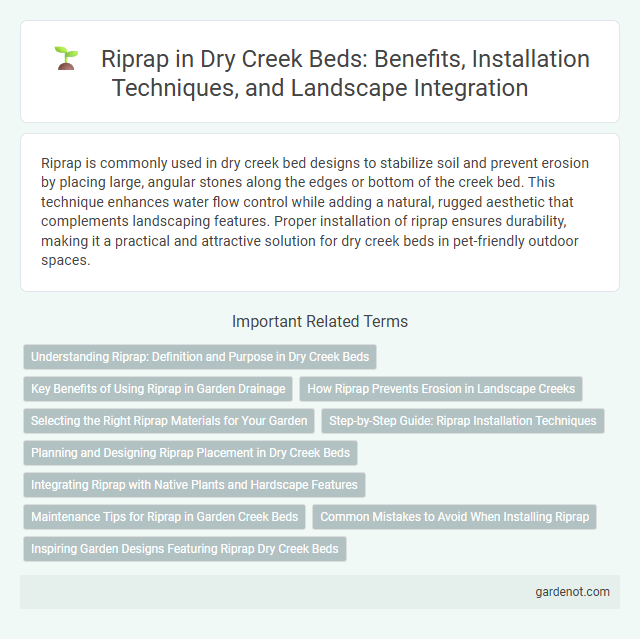Riprap is commonly used in dry creek bed designs to stabilize soil and prevent erosion by placing large, angular stones along the edges or bottom of the creek bed. This technique enhances water flow control while adding a natural, rugged aesthetic that complements landscaping features. Proper installation of riprap ensures durability, making it a practical and attractive solution for dry creek beds in pet-friendly outdoor spaces.
Understanding Riprap: Definition and Purpose in Dry Creek Beds
Riprap consists of large, angular stones strategically placed along dry creek beds to prevent soil erosion and stabilize banks. Its primary purpose is to absorb and deflect the energy of flowing water, reducing the impact that causes sediment displacement and channel degradation. Proper installation of riprap enhances water flow management while protecting the structural integrity of dry creek channels.
Key Benefits of Using Riprap in Garden Drainage
Riprap provides exceptional erosion control by stabilizing soil along dry creek beds, protecting landscape contours from heavy rainfall and runoff. Its permeability allows efficient water flow, reducing pooling and promoting better drainage in garden areas. The durable nature of riprap ensures long-term maintenance with minimal repair, making it an ideal solution for sustainable garden drainage management.
How Riprap Prevents Erosion in Landscape Creeks
Riprap consists of large, angular stones strategically placed along dry creek beds to stabilize soil and absorb the energy of flowing water, effectively reducing erosion. By disrupting the force of runoff, riprap prevents soil displacement and maintains the integrity of creek banks and beds. This durable barrier promotes vegetation growth by protecting root systems, further enhancing erosion control in landscape creeks.
Selecting the Right Riprap Materials for Your Garden
Selecting the right riprap materials for your garden involves choosing durable, weather-resistant stones that effectively prevent soil erosion in dry creek beds. Opt for angular rocks like granite or limestone, which interlock to provide stability and improve drainage while complementing the garden's aesthetic. Consider the stone size carefully, with larger boulders for heavy flow areas and smaller rocks for gentle water channels, ensuring long-lasting functionality and visual appeal.
Step-by-Step Guide: Riprap Installation Techniques
Installing riprap in a dry creek bed involves preparing the site by clearing debris and grading the area to ensure proper drainage. Place large, angular stones along the banks, starting from the lowest points and working upward, ensuring each layer is stable and interlocked to prevent erosion. Secure the riprap with geotextile fabric beneath the stones to enhance stability and filter soil, maintaining long-term effectiveness in channel protection.
Planning and Designing Riprap Placement in Dry Creek Beds
Effective planning and designing of riprap placement in dry creek beds involves analyzing soil stability, flow velocity, and erosion risks to ensure long-term structural integrity. Selecting appropriately sized, angular rock materials and strategically positioning them along vulnerable banks reduces sediment displacement and channel degradation. Incorporating geotextiles beneath riprap enhances foundation support, while maintaining natural water flow patterns preserves the ecological balance of the creek bed.
Integrating Riprap with Native Plants and Hardscape Features
Riprap, consisting of large, angular stones, stabilizes dry creek beds by preventing erosion and controlling water flow. Integrating riprap with native plants enhances soil retention, promotes biodiversity, and creates a natural aesthetic by blending hardscape with vegetation. Incorporating hardscape features like stepping stones or benches alongside riprap and native plants provides functional and visual harmony in landscape design.
Maintenance Tips for Riprap in Garden Creek Beds
Regular inspection of riprap in garden creek beds is essential to identify displaced or eroded stones that compromise stability. Periodically replenishing and realigning rocks maintains effective erosion control and preserves natural flow patterns. Removal of debris and vegetation growth between riprap stones prevents clogging and reduces water diversion risks.
Common Mistakes to Avoid When Installing Riprap
Common mistakes to avoid when installing riprap in a dry creek bed include improper sizing of stones, which can lead to erosion or instability. Failing to prepare the subgrade adequately or neglecting to place a filter fabric beneath the riprap often causes soil migration and undermines the structure. Incorrect placement techniques, such as uneven layering or insufficient compaction, reduce effectiveness in controlling runoff and protecting the creek bed.
Inspiring Garden Designs Featuring Riprap Dry Creek Beds
Riprap dry creek beds transform landscapes by combining natural stone with strategic placement to control erosion and enhance visual appeal. Incorporating varied sizes of angular rocks creates dynamic textures that mimic natural water flow, promoting sustainable drainage and adding structural interest. These inspiring garden designs not only manage runoff effectively but also serve as striking focal points in xeriscaping and drought-tolerant landscapes.
Riprap Infographic

 gardenot.com
gardenot.com